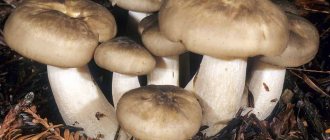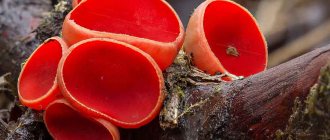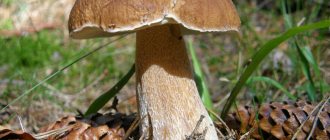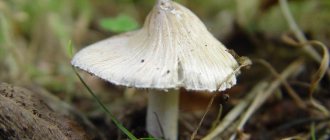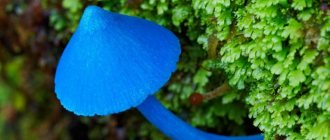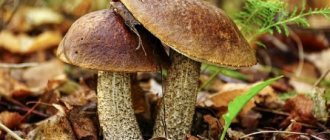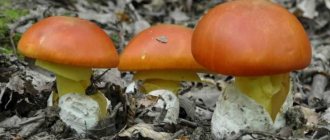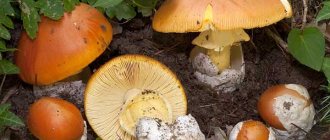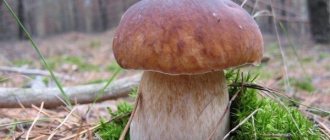Sarcoscypha is one of those mushrooms that have a very attractive appearance.
With a rich imagination, they can even be compared to scarlet flowers, especially if these original fruiting bodies grow not on dry wood, but on lush green moss. In this case, it seems as if a dense, bright bud is surrounded by bright green leaves. The first beautiful mushrooms after the snow melts are spring Sarcoscypha mushrooms, bright red, resembling small red cups. Although these mushrooms are small, they are surprisingly bright, which evokes a feeling of joy. Their appearance tells everyone: real spring has finally arrived! These mushrooms can be found everywhere: near roads, paths, on the edges, deep in the forest. They can grow in thawed areas next to snowy areas.
Description
The mushroom belongs to the genus Sarcoscypha, a family of the same name, and is a species of marsupial.
Despite its rarity and uniqueness, this species is not included in the Red Book. It is widespread throughout the world: in Asia, Africa, Europe, America, Australia. Sarcoscipha has a number of other names. Latin Sarcoscypha coccinea and Sarcoscypha austriaca, it is also often called bright red Sarcoscypha or cinnabar red. The names Sarkoscyfa Austrian, Petsitsa red and Scarlet Elf's Cup are found.
If we describe the appearance of the mushroom, then it is a saprophyte that grows on the trunks or branches of trees; it has a fairly small size, elastic flesh, and a low stalk. But the main feature is the cap, which is the fruiting body. It looks like a bright red saucer, the size of which is from 1.5 to 5 centimeters in diameter. The edges of the cap are turned inward and are pale pink or white.
A hymenophore is a part of the fruiting body of a fungus that bears a thin spore-bearing layer on the surface. In Sarcoscypha it has a pale pink or white color and a frequent structure without divisions into stripes. The pulp is elastic, with a pleasant mushroom aroma.
A little history
It is the type species of the genus Sarcoscipha. Scientists from Europe (presumably Austria) described it in 1772, although it had been known for a long time.
The mushroom was first used as food long before its official discovery. It was known to ancient hunters and gatherers.
Application
Improper preparation of mushrooms can lead to poisoning
Sarcoscipha is used both as food and for the manufacture of folk medicine.
In medicine
Sarcoscifu is used for poisoning and if a natural antiseptic becomes necessary. Self-medication is strictly prohibited, since the mushroom has a list of characteristic contraindications. There are also age restrictions for use.
In cooking
When preparing dishes containing these mushrooms, you should be careful: incorrect proportions can lead to poisoning.
There are several ways to prepare the product. Be sure to follow the recipe strictly to achieve food that is free of toxins.
It is used:
- fried;
- steamed;
- stewed;
- pickled;
- saline.
More often, the mushroom is used to decorate and serve the table.
In cooking, the fruiting body of the product is more often used: the stem collects all the toxins and dirt. It is used only for pickling after long boiling: it gives additional juice. In general, taste preferences are a purely personal matter. Therefore, Sarcoscipha is not an acquired taste mushroom. Those who have already eaten it claim that after boiling, the density of the mushroom resembles chicken cartilage. They say that sarcoscyphs are not bad when stewed.
Time and place of fruiting in Russia and the world
The time of appearance of this mushroom is late winter or early spring. But already in May the fruiting process ends. The first fruiting bodies begin to be collected at the end of winter.
They grow in ecologically clean places in areas with a temperate climate. Found in the forests of Eurasia, Africa, and America. It’s not easy to find them - mushrooms choose dead wood, branches and fallen leaves. Sometimes seen on the remains of trees and moss. They grow in groups, and in the warm fall a second crop of mushrooms may appear in some areas.
Sarcoscipha is also found in the forests of Russia and is common in its European part; there are especially many such mushrooms in Karelia.
Appearance
The hat (as the name implies) is bright red with a white edge slightly curved inward, similar to small red cups. The width of the cap is 1-5 cm, height 0.5-2 cm. The lower surface of the cap is almost smooth, the color is dirty white.
The leg is whitish, short, tapering towards the bottom. It grows up to half a centimeter thick, 1-3 cm high. The color is the same as the cap.
The pulp is firm, with a pleasant mushroom smell and taste.
Very rarely, this mushroom has albino brothers. These specimens lack one or more pigments, so the mushrooms are white or yellow in color. Scientists believe that the weather in this case does not affect the color, since the mushrooms of a unique color appear in the same place every year.
False doubles
The mushroom has very similar brothers, some of which are poisonous.
| Aleuria orange | Sarcoscypha occidentalis | Hot and caustic russula |
| edible | edible | inedible |
| spherical shape | saucer shape | saucer shape |
| color orange, reddish | the color is reddish, brighter than the original | ocher color |
| The leg is shorter | The leg is longer | The leg is longer |
| Non-poisonous | Non-poisonous | Poisonous |
| The area coincides | Grows only in the USA | Grows in Western Europe |
IMPORTANT: the pungent russula is the most dangerous species presented. It differs in that it has an ocher color, but the cap is often similar in appearance to Sarcoscipha - also reddish.
However, the mushroom itself is dangerous to health. Even after trying it, a person experiences a strong burning sensation on the tongue. By the way, the older the mushroom, the brighter its cap.
When consumed, it can cause symptoms similar to ordinary poisoning, but in children it can cause serious health problems.
Sarcoscipha scarlet
| Group: | Marsupials |
| Records: | None |
| Color: | Scarlet, pinkish white |
| Info: | Has a bowl shape |
| Department: | Ascomycota (Ascomycetes) |
| Sub-department: | Pezizomycotina (Pezizomycotina) |
| Class: | Pezizomycetes |
| Subclass: | Pezizomycetidae (Pezitsomycetes) |
| Order: | Pezizales |
| Family: | Sarcoscyphaceae |
| Genus: | Sarcoscypha (Sarkoscypha) |
| View: | Sarcoscypha coccinea (Sarcoscypha scarlet) |
There are mushrooms whose value does not lie in their edibility or medicinal qualities. Their value is purely aesthetic. And Sarcoscipha scarlet belongs to such mushrooms. It competes for the title of the first spring mushroom with morels and strings, and its picturesque fruiting bodies become the first truly bright spots among the white and gray colors of the early spring forest.
Fruiting body
Ascocarp (the so-called fruiting body of Sarcoscypha scarlet) is a dense cup of rather modest size (from 1 to 5 centimeters), outside having a white or pinkish-white color, and inside painted in a bright, catchy cinnabar-scarlet color.
The bowl is located on a short, about 3 centimeters, stem, colored the same as the outside of the mushroom bowl. The thickness of the leg reaches 6 centimeters.
To the touch, the surface of the mushroom is tender, velvety, the flesh on the crack is pink-red, mushroom aroma and neutral taste. Sarcoscipha scarlet spores ripen on the inner surface of the cup, have an ellipsoidal shape and a pink-red color.
Distribution and collection
Sarcoscipha scarlet is a completely cosmopolitan mushroom and is found on all continents except Antarctica. In our latitudes, Sarcoscipha scarlet is found both in coniferous and deciduous, as well as mixed forests. This fungus settles on dead, rotting wood, preferring deciduous trees - beech, oak, maple and willow. Grows in groups, often numerous.
Similar species
Sarcoscypha occidentalis
It grows on a longer stem, lighter in color than Sarcoscypha scarlet. It is not found in our latitudes; its homeland is Central America and the USA.
Use
Now many sources on the Internet indicate that Sarcoscipha scarlet is an edible mushroom and recommend boiling it for 15 minutes before eating. Those who have tried it note that this mushroom is tasty, but has rather hard, cartilaginous flesh.
However, the authors of such recommendations do not take into account the need for long-term studies of the consequences of consuming this type of mushroom. It is known that many mushrooms contain small amounts of substances that, when consumed regularly, have a cumulative effect, the effect of accumulating a critical mass.
It is unknown whether Sarcoscipha scarlet contains similar substances, so it is not recommended to eat this mushroom regularly.
Interesting Facts
Sarcoscifa is an excellent ecological biomonitor demonstrating the ecological state of the forest. It never grows in polluted areas, near industrial zones and roads. If you see scarlet sarcoscypha in the forest, you can be sure that this part of the forest is ecologically safe.
Primary processing and cooking recipes
When preparing, mushrooms must be cleaned of moss and dirt, but do not rush to immediately lower them under running water. It is better to soak the fruits in a basin or pan, and then carefully clean off any remaining dirt.
Then trim the stem, separate the caps and place them on a piece of cloth or gauze on the windowsill. When the mushrooms are dry, you can collect them in a container and put them in the freezer. Or soak them in order to later prepare some kind of dish from them.
Extinguishing
Ingredients
- sarcoscipha - up to 1 kg;
- Onion - 1 pc.;
- Salt - 2 tbsp;
- Olive oil - 2 tbsp;
- Carrots - 1 pc.;
- Tomatoes - 3 pcs.
Preparation
- It is best to stew sarcoscipha finely chopped in a slow cooker.
- To do this, mushrooms are salted, a little olive oil, chopped carrots, onions, and tomatoes are added.
- You need to simmer in a special mode for about 60 minutes.
- The mushrooms can then be served along with soy sauce and rice. The result is an exquisite treat reminiscent of Japanese cuisine.
Frying
Ingredients:
- Sarcoscipha - up to 1 kg;
- Onion - 1 pc.;
- Garlic - 1 pc.;
- Salt - 2 tbsp;
- Olive oil - 2 tbsp;
- Vegetables from a frozen bag - 200 gr.;
- Tomatoes - 3 pcs.
Preparation
- To begin, prepare olive oil, half a glass of water, finely chopped onion and garlic.
- Mushrooms are added when the vegetables have been stewed a little.
- Then sprinkle with a little salt.
- They need to be stirred every seven minutes; frying should be completed after 20–30 minutes.
- Serve with adjika or red sauce with rice dishes or stewed vegetables. And also very tasty in combination with Korean carrots and sour cream.
Pickling
This option for harvesting mushrooms is the most common.
You will need:
- sarcoscipha - up to 1 kg;
- Garlic – 1 pc.;
- Salt - 2 tbsp;
- Table vinegar.;
- Sugar - 1 tbsp. l.;
- Bay leaf - 2-3 pcs.;
- Pepper, cloves - 5 pieces each
Preparation
- Mushrooms should be chopped, placed in a pan with cold water and boiled for up to 30 minutes.
- Then drain the water and brine into another pan, and put the fruits in the marinade and stir.
- Then you can marinate them and put them in the refrigerator. After a day, stir again and store in a cool place.
How to prepare brine:
- Place sugar, pepper, cloves, bay leaf, and garlic in a saucepan.
- Pour water over all this, after boiling, cook for another 10 minutes and add vinegar and vegetable oil.
- After 10 minutes, remove from heat.
Similar species
What forest inhabitants can you easily confuse the boletus with?
There may be many options, however, the answer is obvious. The boletus family includes a huge number of mushrooms and species that thrive in forests, moreover, they grow in abundance in Russia. Let's get acquainted with the most common types that you may likely encounter on your way.
Maiden's boletus
This mushroom has a very interesting and intricate name. It is edible and also belongs to the boletaceae family.
Is a boletus.
Its appearance vaguely resembles a semi-white mushroom. Its cap has a maximum diameter of 20 cm. The shape is predominantly convex, and the edges are curved inward. It seems quite thin, the cap has a golden hue, much less often red or brown.
The pulp itself is very dense and also has a blue tint when cut.
The leg reaches a maximum height of 15 cm, very thick, up to 6 cm in diameter.
This species is widespread in southern Europe, however, such boletus cannot be found in large groups. Likes to grow alone. Basically, it bears fruit during the early autumn stage.
Boletus root
Another representative of the Boletaceae family, the boletus genus. A mushroom that will certainly not go unnoticed.
Very large, the cap can reach a diameter of up to 30 cm. At the very beginning of growth, it has a cone-shaped shape, but then it takes on a flatter shape, the edges bend inward.
The surface of such a cap is slightly woolly and can often crack.
The flesh of this mushroom has a lemon yellow tint, somewhat bluish. It does not have the most pleasant smell, and the taste is quite bitter.
The stem is thick, lifts the mushroom to a height of 12 cm. It has a yellow tint.
This mushroom is widespread throughout Europe and chooses only deciduous forests for its development. Loves calcareous and other neutral soils. And also prefers dryness. Grows from July to October.
Moss fly green
A mushroom widespread in Russia.
Very beautiful, attracts attention. Despite the name, it belongs to the boletus genus
This mushroom is easy to spot in the forest. Its cap is small, reaching a diameter of 10 cm. Individuals measuring 16 cm are very rare. It is somewhat convex and very velvety. The flesh is white, however, when cut it turns blue.
The leg itself has a cylindrical shape, which tapers slightly towards the mycelium itself. It is about 10 cm in height and up to 2 centimeters in thickness.
Spore powder is brown, frequent.
This mushroom chooses a variety of forests for its growth. In addition, it also prefers clearings and roads.
The mushroom grows singly, and sometimes in groups. Can form mycorrhizae with deciduous and coniferous trees. He is cosmopolitan. It is equally often found in North America, Europe and Australia.
Boletus inedible
Inedible boletus can also be found in Russian forests. However, despite the fact that the name contains the word inedible, this mushroom is not poisonous. The fact is that it is unpleasant to prepare mainly because of its taste. However, it does not pose any danger to the human body.
In order not to confuse this inedible species with a simple porcini mushroom, you need to carefully study the description.
The hat can reach a diameter of up to 15 cm. It has a cone-shaped shape. Sometimes, slightly convex, the edges turn inward or hang in waves.
This hat is very smooth to the touch, somewhat matte and wrinkled. The skin has a light brown tint, but at a young age it is already brown or gray-brown in color.
The pulp itself has a cream or white tint, however, it can sometimes acquire a blue tint when cut. Quite bitter.
The leg rises 15 cm in height and is about 4 cm thick.
As for the tubular layer of this forest dweller, it has a lemon yellow tint; also, a greenish tint predominates. The spore powder itself is brown and olive in color.
This mushroom is widespread in the south of the European part of Russia; it most often chooses the Kaliningrad region for its place of residence. It is also common in Europe, namely in warm countries, such as Italy or Spain. It mainly chooses coniferous forests, also oak and broad-leaved forests. It prefers sandy and acidic soils, and also settles in places in parks and lawns.
Mushrooms grow between July and October.
Interesting Facts
- Mushrooms have not been studied by scientists for their effects on the body after long-term consumption, so they are officially inedible.
- Sarkiscifs grow only in ecologically clean places. If there are factories or even some small industries nearby, this will “scare off” them.
- This mushroom has a huge number of brothers. For example, Sarkoscipha Dudley chose exclusively the territory of America for her growth. You won't find her anywhere else.
Sarcoscifa scarlet, despite its rarity and unusualness, has already entered the diet of many inhabitants of our planet. This mushroom is environmentally friendly and helps intestinal function, although it is not officially recognized as edible. But scientists have yet to study all its properties, including its effect on the human body.
Information sources
- Sarcoscypha coccinea // Mycobank.org, - CBS-KNAW Fungal Biodiversity Center Utrecht, 2016
- Saccardo, P. A. 1889. Discomyceteae et Phymatosphaeriaceae. Sylloge Fungorum. 8:1-1143
Sarcoscipha cinnabar red
Mushroom pickers of all countries - unite! (C) Mushroom pickers on Facebook
Sarcoscypha coccinea
This mushroom appears in the spring, immediately after the snow melts in the forest. Grows on branches of deciduous trees submerged in the ground. It’s hard to say whether it’s worth eating... But it’s clear that the mushroom is a decoration of the spring forest!
Sarcoscipha cinnabar red
Synonyms: bright red sarcoscipha, scarlet cup
Description of the mushroom Sarcoscipha cinnabar-red
The fruiting body of the Sarcoscipha cinnabar-red mushroom is 1-5 cm in diameter, cup-shaped, often almost open at maturity, with a wavy-winding, often cracked edge. The outer surface is whitish or pinkish, sometimes buffy, densely covered with whitish hairs, felt-like. The inner surface is smooth, covered with a bright red or deep pink hymenial layer.
The stalk of the Sarcoscipha mushroom is cinnabar-red, deeply immersed in the substrate, very short, narrowed at the base, hairy, lighter than the “bowl”.
The flesh of the Sarcoscipha mushroom is cinnabar-red, thin, fragile, waxy, reddish, without any particular smell or taste.
The asci of the Sarcoscipha cinnabar-red mushroom are cylindrical, 400-500 x 15-18 µm, 8-sporous.
Sarcoscipha cinnabar-red in Ukraine grows in groups on the branches of dead trees of deciduous trees (including those immersed in the soil) in deciduous forests in April-May. In the mountainous part of Crimea, fruiting bodies are formed mainly in December-March. Occurs infrequently.
The mushroom is inedible. But not poisonous either. In some literary sources, this species is classified as conditionally edible of low quality. It is not particularly valuable from a nutritional point of view.
Similar species: In terms of the shape of the fruiting body, this species is similar to species of the genus Peziza, from which it differs in the bright red color of the inner surface of the “bowl”.
Interesting information about Sarcoscipha vernacular
There is evidence that some Indian tribes prepare powder from dried fruit bodies and use it as a hemostatic agent.
Photos for the description of Sarcoscipha cinnabar-red
Sarcoscipha cinnabar-red Sarcoscipha cinnabar-red Sarcoscipha cinnabar-red Sarcoscipha cinnabar-red Sarcoscipha cinnabar-red
When and where was Sarcoscypha cinnabar red found?
This page is a description of the mushroom Sarcoscipha vernacular according to the mushroom directory. The photographs were taken for an illustrated atlas of mushrooms.
Join our new group
lovers of quiet hunting
Yellow hornet (Ramaria flava)
- Other names for the mushroom:
- Ramaria yellow
- Coral yellow
- Deer horns
Other names:
Description
The fruiting body of Ramaria yellow reaches a height of 15-20 cm, a diameter of 10-15 cm. Numerous branched dense bush-like branches with a cylindrical shape grow from the thick white “stem”. They often have two blunt tops and irregularly truncated ends. The fruit body has all shades of yellow. Under the branches and near the stalk the color is sulfur-yellow. When pressed, the color changes to wine-brown. The pulp is moist, off-white, marbled in the core, and does not change color. Outside, the base is white, with a yellowish tint and reddish spots of varying sizes, most often found on fruiting bodies growing under coniferous trees. The smell is pleasant, a little grassy, the taste is weak. The tops of old mushrooms are bitter.
Spore powder is ocher-yellow.
Habitat and growth time
Yellow hornet grows on the ground in deciduous, coniferous and mixed forests in August - September, in groups and singly. It is especially abundant in the forests of Karelia. It is found in the Caucasus mountains, as well as in Central European countries.
Doubles
The yellow horned mushroom is very similar to the golden yellow coral, the differences are visible only under a microscope, as well as to Ramaria aurea, which is also edible and has the same properties. At an early age it is similar in appearance and color to Ramaria obtusissima, Ramaria flavobrunnescens is smaller in size.
Note
The word flava in the name of the mushroom means “yellow.” Coral fungi are considered basidiomycetes. They form spores on the fruit layer, on the outside of the “knots,” everywhere. For the most part, coral mushrooms are good, edible mushrooms, but among them there are also poisonous ones.
This ramaria is considered an edible mushroom, but certain precautions must be taken when consuming it. First of all, only young specimens should be collected and the base should be used, as the twigs are bitter
Ripe mushrooms are not edible at all due to their bitterness.
wikigrib.ru
Contraindications
The mushroom has a number of contraindications:
The consumption of these mushrooms is prohibited for children under 12 years of age and the elderly, since their bodies do not have enzymes to digest this type of mushroom.
The use of Sarcoscipha mushroom is undesirable during pregnancy: its effect on a woman’s body has not been fully studied.
Caloscypha fulgens: what it looks like, where and how it grows, edible or not
Kaloscypha brilliant: photo and description
Caloscypha fulgens is one of the very beautiful spring mushrooms, but it has no special nutritional value. It is not recommended to collect this species for food consumption, due to the fact that the composition of its pulp has not yet been fully studied. Other names: Detonia fulgens, Peziza fulgens, Cochlearia fulgens.
What does the brilliant Caloscypha look like?
The fruiting body is very small, in most cases about 2 cm in diameter. In young mushrooms, the cap looks like an egg, but after that it opens. In ripe specimens, the fruiting body takes the shape of a bowl with walls curved inward, and small tears are often located along the edge. In older specimens, the appearance is very similar to a saucer.
The hymenium (the inside surface of the mushroom) is matte to the touch, bright orange or yellow, sometimes there are almost red fruiting bodies. The outer side of the caloscypha is shiny and covered with an unclean gray paint mixed with green. The surface is smooth on the outside, however, it often has a whitish coating.
The spore powder is white, some spores are almost round. The pulp is quite tender, even fragile. When cut, it is covered with yellow paint, but upon touch it quickly acquires a blue tint. The aroma of the pulp is weak, pale.
This is a sessile variety, so the mushroom’s stem is quite small. In many cases it is completely absent.
Where and how does it grow
Caloscypha splendor is a rather rare species that can only be found in the west. In Russia, extensive groups of mushrooms are found in the Leningrad region and the Moscow region.
Fruiting of Caloscypha splendor occurs at the end of April - mid-June. Depending on the climate, these dates may shift slightly - for example, in temperate latitudes, the harvest can only be harvested from the end of April to the last days of May. Every year, Kalossypha hardly bears fruit; empty seasons often occur.
This species should be looked for in coniferous and mixed forests, with special attention paid to places under spruce, birch and aspen trees where moss grows and needles accumulate. Sometimes fruiting bodies grow on rotten stumps and fallen trees
In mountainous areas, Caloscypha splendor can be found near accumulations of huge morels and morel caps.
Let's eat the mushroom or not
There is no correct data on the toxicity of caloscypha, however, it is not collected for food consumption - the fruiting bodies are very small. The taste of the pulp and the aroma of the mushroom are impersonal. Classified as inedible.
Doubles and their differences
Caloscypha splendor has very few doubles. It stands out from all similar varieties in that the flesh of its fruiting bodies acquires a bluish color almost immediately after mechanical influence (impact, squeezing). In false species, the flesh does not change its color after touching it.
Orange aleuria (lat. Aleuria aurantia) is the most popular twin of the brilliant Caloscypha. The similarity between them is actually great, but these mushrooms grow in very different periods of time. Orange aleuria bears fruit from about August to October, unlike spring caloscypha.
Such different morels
And here is an old friend - morel (Morchella)! That is, like an old acquaintance, but changed. Here, in Kuban, I often come across morel caps first and a little later - conical morels, but in the Moscow region, I remember, they were mostly real.
In general, there are several types of morels and morel-like mushrooms.
Morel cap (Verpa bohemica). blabtoConical cap (Verpa conica). Fred Stevens
Morel cap and conical cap
I would call the morel cap (Verpa bohemica) a morel bell - its cap is conical, it grows to the stem at the very top, it seems that it even dangles. Otherwise, it looks like a morel.
The conical cap (Verpa conica) can have a smooth cap. The mushroom itself is quite miniature, similar to a finger with a thimble on it. The stems of mushrooms are hollow, although morels have loose flesh inside at a young age. Caps can be confused with morels when viewed from above. Caps prefer wet places. The mushrooms are quite edible, not of the lowest category, but not of the highest category either.
Steppe morel (Morchella steppicola). Viktor SevidovEdible morel (Morchella esculenta). Andreas KunzeSemi-free morel (Morchella semilibera). H. Krisp
Morels
With morels it's not so simple. Morels have long and thoroughly been followed by a trail of information about “conditional edibility,” although these are tasty edible mushrooms that have not been noticed by mycologists in any unhealthy manifestations, and in Europe and America, in general, these mushrooms are considered a delicacy.
Another thing is that inexperienced mushroom pickers often confuse it with a poisonous line, collecting both of them together - here, of course, you need to carefully study each mushroom and throw out everything suspicious.
The steppe morel (Morchella steppicola) is radically different from all others - a squat mushroom with a short or very short stalk, sometimes reaching a size of 25 cm and a weight of 2 kg. And his hat is wrinkled grayish-brown. Grows in wormwood steppes or forest-steppes. Included in the Red Book of Kalmykia, Rostov, Saratov and Volgograd regions.
The most common in Russia is the edible morel (Morchella esculenta) - a mushroom on a long stalk with an ovoid or rounded cap, tightly attached to the stalk. If you cut it, the inside is hollow, just one skin. Therefore, mushrooms are quite light. You can fill the basket full, but it’s easy to carry. When you start frying, you immediately feel that 30% of the forest air has been brought home.
The smooth emptiness inside the morel is a significant difference from a line containing toxic compounds. The line has a tortuous pulp inside, quite chaotically intertwined. The morel is somehow more harmonious, in my opinion.
Cutting morels is a mandatory operation not only to identify the mushroom, but also to drive slugs out of the warm edible place. Or other living creatures that use the morel cavity for their own, not always harmless, purposes.
The strings are most often hidden in the litter, and their curly cap sticks out, while in the morel the stem rises above the litter and the entire mushroom is visible.
It is quite easy to identify the semi-free morel (Morchella semilibera): its cap grows to the stem halfway up, and the bottom is free. It also doesn't smell particularly nice. But it is quite edible, although it is not found often.
There is also the thick-legged morel (Morchella crassipes) with thick, long and somewhat corrugated legs, a rare mushroom.
The conical morel (Morchella conica), the cap of which may not even be conical at all, but round, is similar to the gourmet morel (Morchella deliciosa), but is more common.
Morels grow almost everywhere. In a forest where there is a lot of last year’s dry grass, you need to get used to looking for them; you won’t be able to see them right away. But in burnt areas, not old clearings, in pine forests they are clearly visible and they grow there willingly.
Since ancient times in Rus', morel tincture was used for eye diseases: myopia, farsightedness, lens clouding and cataracts. Morel preparations also have antitumor, immunomodulatory, antiviral and anti-inflammatory activity.
Giant stitch (Gyromitra gigas). Imbi Vahuri
Spring mushrooms 2022 in the Moscow region, picking in the forest
If local residents living close to the forest know firsthand the names of mushrooms common in the area and know how to distinguish edible fruits from poisonous and inedible ones, then city residents know the secrets of quiet hunting not so subtly, and even poorly. This problem often leads to serious mistakes related to health and even life. Fruits containing poisons, mushrooms that grow near roads and factories, as well as false subspecies, are found many times more often in spring than in summer, autumn and winter.
The sweetest prey for mushroom pickers in spring are oyster mushrooms. They are preserved and do not deteriorate even after frost. Not only beginners, but also hunters who know a lot about delicious mushrooms love to collect last year’s mushrooms. They are fried without heat treatment in a frying pan, less often - dried and used as the main ingredient for preparing first courses.
The ecology of Moscow leaves much to be desired. And spring walks are another reason to go with the whole family to fresh air, enriched with oxygen and a favorable climate. In addition, in a few hours you can collect a good harvest, which is suitable for preparing delicious lunch dishes and snacks.
Conditionally edible varieties
Conditionally edible mushrooms can be used for culinary purposes. But before that they must undergo thorough heat treatment.
Russula
The mushroom is often confused with red russula, which is edible. These fruits can only be distinguished after the spores have matured. In the stinging species, they color the inner cap part in an ocher shade. This mushroom is distributed throughout Russia.
Row yellow-red
Young rows have a convex cap, which becomes prostrate when ripe. Diameter – from 7 to 10 cm, but sometimes can reach 15 cm. Color – yellow-orange or yellow-red. There are small scales along the edges.
The stem is cylindrical, solid in a young mushroom, but becomes hollow with age. The pulp is juicy, thick, yellow. The taste of the mushroom is pleasant, the smell is slightly sour.
The yellow-red row can be found in coniferous forests. It prefers to grow on larch stumps, as well as in areas of dead wood, rubble, and floodplains. The mushroom bears fruit in July-September.
Red boletus
Red boletus is a harmless edible mushroom that can be put into a basket without a doubt. You can prepare many delicious and healthy dishes from it, as well as make preparations for the winter. The species grows mainly in coniferous forests; fruits can be collected from June to October.
The species can be distinguished by its bright red-orange cap, which is why the mushroom is popularly called “blood-red.” Its diameter is from 5 to 15 cm. At a “young” age, the cap looks convex, as if “stretched” on a stem, but over time it opens up, forming an outstretched area with velvety skin.
The boletus pulp is initially dense and white, but when cut it quickly turns blue-black. The leg is stable, cylindrical in shape with thickening downwards. The height reaches 15 cm, the diameter up to 5 cm. The leg goes deep into the ground and in the lower part is characterized by a green tint, covered with fibrous longitudinal scales.
Hygrocybe purpurea
It is very easy to recognize this mushroom, since it has an unusual, characteristic color. The size of the fruit is small - its cap grows to only 3 cm. The plates grow together with the stem using teeth. The pulp has a bright red or red-orange hue. However, the color changes at the break.
The leg grows up to 7 cm and reaches 0.3-1 cm in diameter. Its shade is the same as that of the cap, but may be more saturated. At first it has a cylindrical shape, but over time it can bend.
Note!
Hygrocybe purpurea grows in grassy forests or meadows with fertile soil.
Fruiting of the mushroom occurs in the summer-autumn period.
Red milk mushroom
It has a reddish-brown color, the diameter of the cap is about 20 cm. Its surface is matte and has a light brown color. In damp weather, the surface of the fruit becomes mucous.
The flesh of the red milk mushroom breaks easily and is white or reddish in color. The aroma is unusual, similar to the smell of boiled crabs, but can smell like herring.
Cobweb bracelet
The diameter of the cap is from 4 to 12 cm, the thickness of the stem is 1-2 cm, and the height is 5-14 cm. In young specimens, the cap has a hemispherical shape, but gradually opens up as it grows. The surface is dry, orange or red-brown in color.
The mushroom can be found in forests of any type from the beginning of August until the end of the warm autumn period.
Honey fungus brick-red
Main parameters of the mushroom:
- Hat. It has a diameter from 4-8 to 12 cm, first round-convex, then semi-prostrate in shape. The color is brick-red, brownish or yellow-brown. The pulp is slightly bitter, the color is white-yellow.
- Leg. It grows 6-10 cm in length and up to 1.5 cm in thickness.
The mushroom can be collected in the summer-autumn period. Grows on stumps and dead wood.
Accelerometer calibration
When the auto-rotate screen function is enabled in the settings, but when the position of the smartphone relative to the horizontal axis changes, the screen orientation does not change, it is worth calibrating the accelerometer. Before doing this, you need to place the device on a strictly horizontal surface. Further:
- Dial the code *#*#3646633#*#* on your phone to get to the engineering menu.
- Open the “Telephony” > “Hardware Testing” menu.
- Find the “Sensor” menu.
- Select “Sensor Calibration”.
- To set up calibration in a new way, in the menu that opens, first click “Clear Calibration”, then “Do Calibration (20% tolerance)”.
- Exit the engineering menu by pressing the phone's "Back" button several times in a row.
To check the changes made, it is recommended to use the Building level, Bubble level, Waterpas building level application.
Obabki
Despite the fact that boletus mushrooms are usually called obabki, that is, mushrooms with brown caps, according to science it is a whole genus of mushrooms, which includes not only brown boletus mushrooms, but also all kinds of red-headed boletus mushrooms. And what’s most interesting is that there are several types of both. However, the average mushroom picker has never bothered about their diversity, and distinguishes these mushrooms only by the color of their caps. Well, because some of them are found under birches, and some - under aspens.
boletus
Since from time immemorial these mushrooms have been called little ones, we will begin our review of this group with them.
Common boletus
Captured (in all its glory) in the photo above, which headlines the gag section. It is found, of course, in birch forests, or mixed ones, but always with an admixture of birch. It can also grow in the tundra - among dwarf birches, and often has a sprout that is taller than the latter, which is why it is jokingly called “overbirch birch” among tundra inhabitants.
Appears already in June, often in the first half of the month. Continues to bear fruit for quite a long time - until the first half of October. However, everything here depends on the autumn and how early the frosts hit.
Black boletus
It is very similar to the previous species, in fact it is its complete double, differing only in a slightly darker color. But it is better not to use this as a distinctive feature, because both boletus mushrooms are prone to variations in the color of the caps in the dark or light direction. Usually mushroom pickers cannot distinguish between the two at all.
It does not bear fruit for as long as an ordinary boletus, usually from July to September. In October it can hardly be found.
White boletus
And there is one. It has the lightest color of all boletuses, and sometimes it is completely snow-white. It differs from its previous brothers in that it is drawn to damp, wetlands.
White boletuses grow from July to the end of September.
Boletus
They differ from boletus mushrooms in that they form mycorrhiza with aspen. Well, and a brighter color of the hat.
It bears fruit from early June to September; in warm autumn it can also be found in October.
Red boletus
But this fungus is absolutely indifferent to what tree it grows under. The only “requirement” is that this tree be deciduous. But most often it is found precisely in those forests where aspen grows.
Fruits from June to October. It appears en masse in three “waves”: at the end of June, in mid-July, and also in the second half of August - the first half of September.
White boletus
It turns out that among the boletus mushrooms there is also a light (up to complete whiteness) variety, which, interestingly, is sometimes considered one of the most real porcini mushrooms (unlike the white boletus mushroom discussed recently). Perhaps this is due to the excellent taste characteristics of white boletus.
It’s funny, but this mushroom avoids deciduous forests, preferring to grow among pines and spruces. I have never come across it, although they say that this mushroom is periodically encountered in the Urals.
Collection time is from June to September.
Inedible mushrooms
Very toxic fruits that should not be eaten. The most popular types of inedible mushrooms are:
- The pale grebe is recognized as the most terrible species.
- False chanterelle has a pungent odor. The color is orange, not yellow, as in edible form.
- False puffball becomes inedible only in large quantities. A small portion will not cause harm to health.
- Red fly agaric, familiar to every person since childhood. Covered with white spots.
Some varieties cause mild illness, others cause hallucinations, and the third is completely poisonous and can be fatal.
Transit of Venus across the Sun
Transit of Venus across the Sun
- a type of astronomical passage (transit) - occurs when the planet Venus is located exactly between the Sun and Earth, covering a tiny part of the solar disk. At the same time, the planet looks from Earth as a small black speck moving across the Sun. Transits are similar to solar eclipses, where our star is occluded by the Moon, but although Venus is almost 4 times the diameter of the Moon, during the transit it appears about 30 times smaller than the Sun, since it is much further from Earth than the Moon. This apparent size of Venus makes it accessible to observation even with the naked eye (only with filters from bright sunlight), in the form of a point, at the limit of the eye's resolution. Before the era of space exploration, observations of this phenomenon allowed astronomers to calculate the distance from the Earth to the Sun using the parallax method; in addition, when observing the passage of 1761, M.V. Lomonosov discovered the atmosphere of Venus.
The duration of the passage is usually several hours (in 2004 it lasted 6 hours). At the same time, this is one of the rarest predictable
astronomical phenomena. Every 243 years, 4 passages are repeated: two in December (with a difference of 8 years), then a gap of 121.5 years, two more in June (again with a difference of 8 years) and a gap of 105.5 years. The last December passages occurred on December 9, 1874 and December 6, 1882, and the June passages occurred on June 8, 2004 and June 6, 2012. Subsequent passages will occur in 2117 and 2125, again in December. During the passage, the “Lomonosov phenomenon” is observed, as well as the “black drop effect”.
Butter
Butterflies are very popular and numerous in our forests. Surely every mushroom picker has met them and definitely collected them. They are so named because of their shiny cap, which has an oily appearance. There are several varieties of butter. The most popular: granular, late and deciduous.
General description:
- The boletus cap has a diameter of 6-10 cm;
- The color varies from light to dark brown, oily, sticky;
- The leg is 3-6 cm long;
- It is white or slightly gray;
- The pulp is yellow and does not change color;
- The tubular coating is thick, yellow, sometimes covered with a film.
Butter has a wonderful taste and an equally attractive aroma. Most often they are pickled or salted. This is exactly how housewives and household members are used to seeing them on their tables. But they also butter, fry, boil and stew.
Butter
